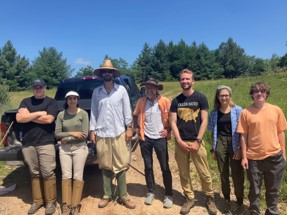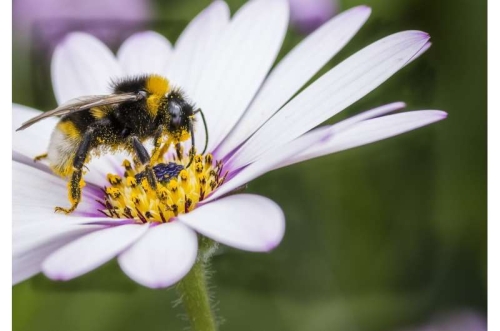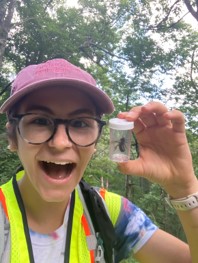by T'ai Roulston, Curator, State Arboretum of Virginia
We hear plenty about the plight of honey bees --the challenges beekeepers have maintaining their colonies due to diseases, parasites and pesticides. The one thing honey bees have going for them, though, is people: new beekeeper organizations sprouted up around the country and old ones filled their ranks with new members when colony collapse disorder struck in 2006. So honey bees remain abundant, despite the greater difficulties of keeping them.

Blandy researchers looked far and wide for bumble bees.
Other bees, however, are not so lucky. Two bumble bee species are now on the endangered species list and several more are being considered for listing. The rusty patched bumble bee is one of them. An eastern species, it used to be fairly common in its range from Maine to North Dakota, south along the Appalachians as far as Georgia. In the last 30 years, it's lost 87% of its range and is rare almost everywhere it is still found. Only near Minneapolis and Madison can someone go for a stroll and have a reasonable chance of finding one. In the last 5 years, it has been found only in the upper midwest and the mountainous border zone of Virginia, West Virginia and the Maryland panhandle, two very different regions that may have little to unite them other than a rare bumble bee.

Photo credit: CC0 Public Domain photo
What happened to the rusty patched bumble bee or the other declining bumble bees is not clear. The only thing they are known to have in common and do not share with other bumble bee species is a high prevalence of a fungal disease called Vairimorpha bombi (=Nosema bombi), a disease that became common in the U.S. at the time when commercial bumble bee rearing began in the 1980s. It is not typically a fatal disease but can be. Did it push several species into decline as the one additional stress they couldn't take, when systemic pesticides came into use and intensive agriculture pushed out the weeds that fed the bees? It is hard to know for sure but that is the best theory going at the moment.
I spent part of this past summer with two students, Lindsey Monteith, an undergraduate from William & Mary, and Preston Thompson, a beginning Ph.D. student at UVa. We scoured the mountains west of Harrisonburg, Virginia (Shenandoah Mountain) and east of Wardensville, West Virginia (North Mountain) to learn what we could about the habitat where the bee still lives. We also wanted simply to find it. We drove the Blandy van to an inch of its life on pot-holed mountain roads; we drove the Blandy 4-wheel drive pickup as far as the truck and I were willing to go on roads that went from gravel to stones to washouts speckled with boulders. We walked when we needed to; we camped when the sun fell, and we were nowhere near where we expected to be.
We found the bees' favorite flowers (black cohosh, hydrangea, wild rhododendron), but we almost didn't find the bee at all. And then ...I clambered up a steep slope from a cohosh patch to the road with nothing to show for my efforts but briar scars when I saw Lindsey standing with a vial in her hand. She was calm, but it was that kind of calm that hides an inner tornado. She held up the vial and nodded. There it was, the bumble bee with the rusty patch flying up and down in the vial, the first live one either of us had ever seen. We photographed it to report the location to the U.S. Fish and Wildlife Service, then let it go. We didn't see another one the rest of the summer. In total, we identified and counted about 2,000 bumble bees while looking in likely places to find the rusty patched bumble bee. Even in the heart of where it still can be found in our area, it is still very difficult to find.

Lindsey Monteith with the only rusty patched bumble bee the Blandy team found after months of searching.
In the end, we learned a lot about the mountain habitats of the Virginia-West Virginia border and how the bee communities change with elevation and with vegetation. We learned what our vehicles could and could not do. We learned not to trust maps or the availability of cell service or GPS, and that a sign that says road closed 4 miles ahead on a very slow washed out road just might mean it. And we learned that the bee we've mostly lost is still amidst us if you look really, really hard.
